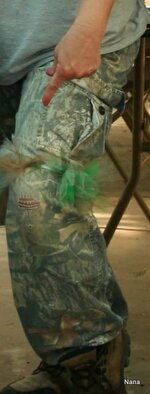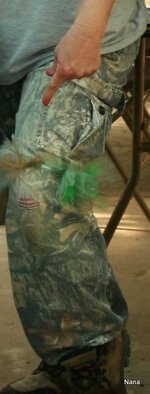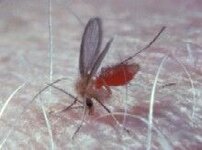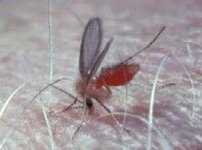- Jan 6, 2006
- 20,845
- 2,532
- 🏆 Honorable Mentions:
- 1
- Detector(s) used
- Garrett AT Pro, Ace 250 & Ace 400
- Primary Interest:
- All Treasure Hunting
Re: The CTH4 hunt will be held September 3,4 & 5th in Caldwell.
Kansas Cattle Drive To Mark Sesquicentennial
The Wichita Eagle
Aug. 22, 2011
Oklahoma marked its centennial in 2007 with a Chisholm Trail cattle drive. Kansas is marking its 150th anniversary with a 200-mile drive on the Cox Trail starting Sept. 5.
At age 61, Jim Gray realizes he is about to take on a job traditionally held by a 20-year-old.
For three weeks in September, Gray — a longtime rancher and cowboy historian from Ellsworth and publisher of the Kansas Cowboy newspaper — will step back in time and become one of the herd drovers on a 200-mile cattle drive that will cross much of south-central Kansas.
The drive is in celebration of the 150th anniversary of Kansas' statehood and acknowledges the contribution the cattle industry has played in the state's heritage.
Beginning Sept. 5, a herd of longhorn cattle will be driven along the old Cox Trail from Caldwell to Ellsworth.
The cowboys, cowgirls and their horses will sleep out under the stars. The drovers will suffer from saddle burns and aching muscles, embrace the weather and indulge in only a few 21st century amenities: portable toilets, cellphones, corporate sponsorships and motorized chuckwagons.
Everything else is as authentic as it was in 1876, when the last herd was driven up the trail.
Cost to ride along on the trip as a guest drover is $2,500 a week and almost all the spots are taken.
"Why do I want to participate? Gray said. "It goes back to growing up and having that gnawing question in the back of my head, 'What would it have been like to do it day in and day out?' "
The idea for driving the herd came after Kansans watched how popular it was in 2007 when Oklahomans celebrated their state's centennial by driving a herd along a portion of the state's Chisholm Trail.
At trail's end, when the dusty and tired cowboys and cattle pulled into Caldwell along the Kansas-Oklahoma state line, more than 10,000 people lined the streets to see an honest-to-goodness old-fashioned cattle drive.
"We'd be going down a road in the middle of nowhere and people would be parked in the middle of intersections watching us go by," said Mike Clover, the chairman and trail boss.
Clover, who lives in Kingman, has organized the Kansas drive as well and expects nothing less.
"We anticipate a lot of people in that we'll be going so close to Wichita, Dodge City and Hutchinson," Clover said.
This summer's drought has played havoc with some of the plans, Clover said. Only 200 cattle will begin the trip because of a shortage of good grass and access to water.
But as the drive progresses, more cattle will be added so that by trail's end on Sept. 24 in Ellsworth, more than 400 longhorns will be part of the herd.
In Kansas, the heyday of the long cattle drive was from the late 1860s to 1887. The typical herd had about 2,000 head of cattle with a trail boss and a dozen men. Most herds moved at a mile per hour, covering between seven and 10 miles a day.
And because it was such hard work, the average age of a cowboy more than a century ago was between 19 and 20 years old; some were as young as 15.
"None of us honestly believe we can reach the full experiences the cowboys of the 19th century had," Gray said. "We are not going to be on open range with half-wide cattle that would stampede at the strangest noise or riding half-loco mustangs. But there are some things that will allow us to get close to that original experience."
The prairie, cattle and the Old West have shaped the state and its people, Gray said.
"The idea of the cowboy is buried deep within us — that almost all Americans can identify with," he said. "I honestly believe the prairie molds who we are and how we think, see and feel.
"This cattle drive represents that time period when all there was was open prairie with no fences to hold us back. Our determination was what carried us through.
"We know now there are fences out there — but we don't have to see them. We can see the sunset that's way off on the horizon, and we know we can go there."
Read more: http://www.kansas.com/2011/08/22/1982791/cattle-drive-to-mark-150-years.html#ixzz1VrIbEFg2
Kansas Cattle Drive To Mark Sesquicentennial
The Wichita Eagle
Aug. 22, 2011
Oklahoma marked its centennial in 2007 with a Chisholm Trail cattle drive. Kansas is marking its 150th anniversary with a 200-mile drive on the Cox Trail starting Sept. 5.
At age 61, Jim Gray realizes he is about to take on a job traditionally held by a 20-year-old.
For three weeks in September, Gray — a longtime rancher and cowboy historian from Ellsworth and publisher of the Kansas Cowboy newspaper — will step back in time and become one of the herd drovers on a 200-mile cattle drive that will cross much of south-central Kansas.
The drive is in celebration of the 150th anniversary of Kansas' statehood and acknowledges the contribution the cattle industry has played in the state's heritage.
Beginning Sept. 5, a herd of longhorn cattle will be driven along the old Cox Trail from Caldwell to Ellsworth.
The cowboys, cowgirls and their horses will sleep out under the stars. The drovers will suffer from saddle burns and aching muscles, embrace the weather and indulge in only a few 21st century amenities: portable toilets, cellphones, corporate sponsorships and motorized chuckwagons.
Everything else is as authentic as it was in 1876, when the last herd was driven up the trail.
Cost to ride along on the trip as a guest drover is $2,500 a week and almost all the spots are taken.
"Why do I want to participate? Gray said. "It goes back to growing up and having that gnawing question in the back of my head, 'What would it have been like to do it day in and day out?' "
The idea for driving the herd came after Kansans watched how popular it was in 2007 when Oklahomans celebrated their state's centennial by driving a herd along a portion of the state's Chisholm Trail.
At trail's end, when the dusty and tired cowboys and cattle pulled into Caldwell along the Kansas-Oklahoma state line, more than 10,000 people lined the streets to see an honest-to-goodness old-fashioned cattle drive.
"We'd be going down a road in the middle of nowhere and people would be parked in the middle of intersections watching us go by," said Mike Clover, the chairman and trail boss.
Clover, who lives in Kingman, has organized the Kansas drive as well and expects nothing less.
"We anticipate a lot of people in that we'll be going so close to Wichita, Dodge City and Hutchinson," Clover said.
This summer's drought has played havoc with some of the plans, Clover said. Only 200 cattle will begin the trip because of a shortage of good grass and access to water.
But as the drive progresses, more cattle will be added so that by trail's end on Sept. 24 in Ellsworth, more than 400 longhorns will be part of the herd.
In Kansas, the heyday of the long cattle drive was from the late 1860s to 1887. The typical herd had about 2,000 head of cattle with a trail boss and a dozen men. Most herds moved at a mile per hour, covering between seven and 10 miles a day.
And because it was such hard work, the average age of a cowboy more than a century ago was between 19 and 20 years old; some were as young as 15.
"None of us honestly believe we can reach the full experiences the cowboys of the 19th century had," Gray said. "We are not going to be on open range with half-wide cattle that would stampede at the strangest noise or riding half-loco mustangs. But there are some things that will allow us to get close to that original experience."
The prairie, cattle and the Old West have shaped the state and its people, Gray said.
"The idea of the cowboy is buried deep within us — that almost all Americans can identify with," he said. "I honestly believe the prairie molds who we are and how we think, see and feel.
"This cattle drive represents that time period when all there was was open prairie with no fences to hold us back. Our determination was what carried us through.
"We know now there are fences out there — but we don't have to see them. We can see the sunset that's way off on the horizon, and we know we can go there."
Read more: http://www.kansas.com/2011/08/22/1982791/cattle-drive-to-mark-150-years.html#ixzz1VrIbEFg2



 Heck, as long as ya bring a pair of flip flops, everything's good...well....bug spray. Ya'll make sure to bring that bug spray!
Heck, as long as ya bring a pair of flip flops, everything's good...well....bug spray. Ya'll make sure to bring that bug spray!  Those gnats will carry you off.
Those gnats will carry you off.  You sure are not kidding about those gnats either! sheeeesh!
You sure are not kidding about those gnats either! sheeeesh! 




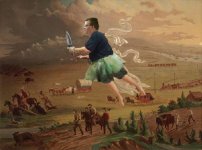
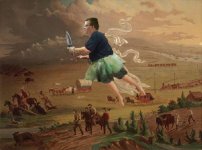


 Wonder if garlic oil works for these?
Wonder if garlic oil works for these?
